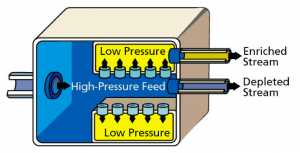Uranium is a radioactive metal that can be mined from the Earth. Its radioactivity comes from its unstable isotopes uranium-238 and uranium-235. While most of the uranium that is mined is uranium-238, the creation of nuclear power and nuclear weapons requires uranium-235. This is because both technologies rely on fission, and uranium-235 goes through fission more readily. The method of changing uranium-238 to uranium-235 is known as enrichment.
Today, two techniques for enriching uranium are used. The first technique, gaseous diffusion, uses a membrane that allows uranium-235 to pass but halts uranium-238. The main drawback of this technique is that the procedure releases gaseous uranium into the atmosphere. The second technique uses gas centrifuges to separate heavier uranium-238 from lighter uranium-235 through high-speed rotations. The heavier uranium-238 flows to the outside, while the lighter uranium-235 remains closer to the center of rotation. This technique also has its drawbacks, in that the centrifuges used are large and expensive.

However, a recent partnership between General Electric and Hitachi is changing the face of uranium enrichment by eliminating these inconveniences. They are developing a less expensive, less bulky alternative: laser technology. The organization Separation of Isotopes by Laser Excitation (SILEX) developed the necessary lasers, which work by emitting monochromatic radiation. SILEX adjusted the radiation to affect only uranium-235 without affecting the other isotopes. The affected isotope is changed in a manner that allows it to be separated from those that are unaffected.
The technology’s approval has been greeted with mixed reviews. On one hand, the usage of this technology would decrease America’s need to import enriched uranium from countries including Australia, and Canada. On the other hand, it is important to remember that this technology applies not only to nuclear power, but also to nuclear weapons. As the technology becomes less expensive, development of nuclear weapons becomes easier. For this reason, the specifics of the developed lasers are kept classified by both the American and Australian governments.
It has taken years for GE and Hitachi to receive federal approval for their technology, and it is expected to take several more years before the $1 billion project goes into production.
